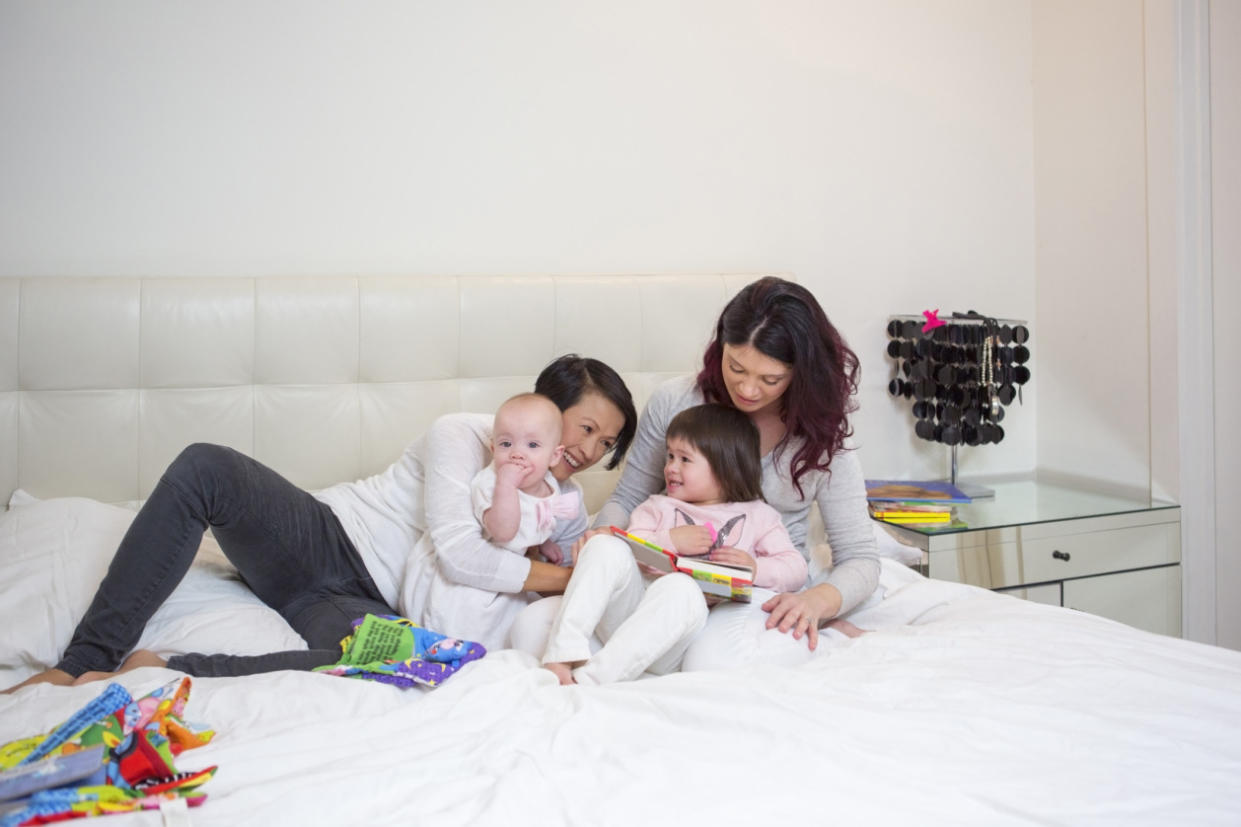Same-Sex Parents Spend More Time With Kids, Study Finds

Kids with two moms may be getting more quality time with their parents — 40 percent more time, in fact, than children with a mom and a dad, according to a new study out of the University of Texas at Austin Population Research Center.
“Leading up to the Supreme Court decision on marriage equality, some of the public dialogue had focused on whether same-sex parents create a different parenting environment for children compared to children who live with a mother and father,” Kate Prickett, postdoctoral fellow and lead study author, tells Yahoo Parenting. “Our study sought to directly test this by looking at the parenting behaviors of a nationally representative, randomly selected sample of parents — something no other studies had examined.”
STORY: The Happiest Parents Just Might Surprise You
What the study found was this: Same-sex parents who are female spend 40 percent more time engaged in child-focused activities than do different-sex parents.
“This finding challenges biases against same-sex parents and demonstrates high levels of investment in children by same-sex couples,” Prickett writes for the U.K.-founded Child and Family Blog this week. (Though the study findings were quietly published online in the journal Demography in June, the article has been generating a fresh wave of press coverage, particularly in Britain, this week.)
STORY: Study: Children Are Most Lovable at This Age
In the blog post, Prickett explains what sort of activities the study looked at. “By child-focused activities, we mean time spent engaged with children in activities that support their physical and cognitive development, such as reading to them, playing with them, helping with homework, bathing them, and taking them to the doctor,” she writes. “It also includes time parents spent in teacher-parent meetings and taking children to extracurricular activities. It did not include activities such as watching television with children or doing housework while a child was around.”
The study’s results were derived from nationally representative data from the American Time Use Surveys, a nationally representative time-diary survey conducted by the U.S. Census Bureau. That pooled 11 years of data — from 2003 through 2013 — with a sample of more than 40,000 parents. However, Pricket notes, that sampling included only 55 parents in same-sex relationships (38 of them being lesbian moms), and therefore, the findings “should be interpreted with caution.”
Still, she writes, “We did find statistically significant differences for parents in same-sex relationships compared with those in different-sex relationships. Furthermore, these differences persisted even when we controlled for a wide range of factors such as age and number of children, hours of work and parental education, all of which influence time spent with children.”
As she tells Yahoo Parenting, “The fact that we find some statistical differences between parents in same-sex relationships versus those in different-sex relationships despite a small sample size is telling. And despite our small sample size of parents in same-sex relationships, a major benefit of our study is that it is nationally representative and participants were randomly selected.” Prior studies on same-sex parenting, she said, have typically relied on convenience sampling, which can produce biased results.
While the findings regarding two-dad families were similar to those of the two-mom families, they weren’t highlighted in the study because the sample size was very small (only 17 gay dads).
What most surprised Prickett, she says, is that “we didn’t find a difference in the amount of time spent with children by women in same-sex couples versus women with different-sex partners.” That’s because the researchers expected that “women with different-sex partners might spend more time with children because they have to compensate for the lower average levels of time spent with children by their male spouses,” she says.
Though the study didn’t seek to explain the findings, there were two main theories about the differences discovered between straight and lesbian couples who are parents.
“First, selection: The way same-sex families come about usually requires a lot more intentionality because you’re partnering with someone who already has children so you know what you’re getting into, or you’re going through insemination or surrogacy or adoption, which are often long and arduous processes,” Prickett says. “Second, despite men spending more time with their children than ever, parenting is still a gendered process. That is, fathers, on average, work more hours and women take on a greater share of home responsibilities.”
The first theory is one that Brent Wright, director of programs for the Family Equality Council, a national LGBT-family advocacy organization, agrees with. “The findings here are very consistent with what I see, because most of our parents tend to be older, as it’s a planned process for most of us,” he tells Yahoo Parenting. “So I think we’ve had lives of being younger and gotten that out of our systems, and so are very child-focused after so much planning.” He adds that findings like Prickett’s are always “exciting” to see.
“I think it really helps dispel negative myths and stereotypes about gay parents,” Wright says. “It shows there really is some rationale around our ability to be good parents.”
(Photo: Romona Robbins Photography/Getty Images)



